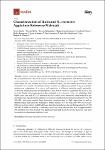Characterization of Ricin and R. communis Agglutinin Reference Materials
Worbs, Sylvia
Skiba, Martin
Söderström, Martin
Rapinoja, Marja-Leena
Zeleny, Reinhard
Schimmel, Heinz
Vanninen, Paula
Fredriksson, Sten-Åke
Dorner, Brigitte
Ricinus communis intoxications have been known for centuries and were attributed to the toxic protein ricin. Due to its toxicity, availability, ease of preparation, and the lack of medical countermeasures, ricin attracted interest as a potential biological warfare agent. While different technologies for ricin analysis have been established, hardly any universally agreed-upon “gold standards” are available. Expert laboratories currently use differently purified in-house materials, making any comparison of accuracy and sensitivity of different methods nearly impossible. Technically challenging is the discrimination of ricin from R. communis agglutinin (RCA120), a less toxic but highly homologous protein also contained in R. communis. Here, we established both highly pure ricin and RCA120 reference materials which were extensively characterized by gel electrophoresis, liquid chromatography-electrospray ionization-tandem mass spectrometry (LC-ESI MS/MS), and matrix-assisted laser desorption ionization–time of flight approaches as well as immunological and functional techniques. Purity reached >97% for ricin and >99% for RCA120. Different isoforms of ricin and RCA120 were identified unambiguously and distinguished by LC-ESI MS/MS. In terms of function, a real-time cytotoxicity assay showed that ricin is approximately 300-fold more toxic than RCA120. The highly pure ricin and RCA120 reference materials were used to conduct an international proficiency test.
No license information

